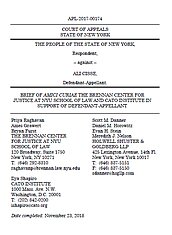This framework remains in effect, but with one wrinkle: in 1994, the Court of Appeals in People v. Reyes held that an officer’s shouted command to “stop!” is a level-one encounter. The conviction of one Ali Cisse depends on the continued validity of Reyes.
On the night of his arrest, Mr. Cisse, then 17, was walking with three friends in Manhattan. A uniformed officer directed Cisse to stop, “hold up and turn around.” Cisse complied, and the officer noticed an L‑shaped bulge in Cisse’s clothing that the officer identified as a firearm. The officer arrested Cisse and seized the firearm and other evidence, which placed Mr. Cisse near the scene of a robbery. The trial court denied Cisse’s motion to suppress the evidence and, relying on Reyes, the state appellate court affirmed.
Yet, the hallmark of a level-one encounter is that it is not “threatening” or “intimidating.” Mr. Cisse thus filed a petition with the Court of Appeals to argue that the police officer performed a “common-law inquiry,” which is a more intrusive interaction than authorized in that circumstance. He maintains that the lower courts misapplied the De Bourframework by relying on Reyes.
Cato has joined the Brennan Center for Justice in filing an amicus brief in support of Cisse. We ask the court to overrule Reyes and hold that an officer’s command to “stop” represents a level-two encounter under De Bour. Twenty-five years of developments in both the law and social science show that a police command to “stop” is more than a mere request for information. Nationwide and state-level research confirms that citizens (including New Yorkers) find police commands to be “threatening” and “intimidating.” Reports show that officers frequently resort to physical force when a subject does not immediately respond to verbal commands, even where the subject poses no imminent threat to the officer or others.
For a level-one encounter, we argue that the “right to walk away” must be restored. Citizens have a right to walk away from police encounters unless they have been seized. “Flight” may give rise to reasonable suspicion when “combined with other specific circumstances indicating that the suspect may be engaged in criminal activity”. The problem lies is the fact that “flight” is often indistinguishable from a suspect’s refusal to abide by a command to stop. To reinstate the right to walk away, the court should require the police to have a basic level of suspicion before they issue a command to stop.
